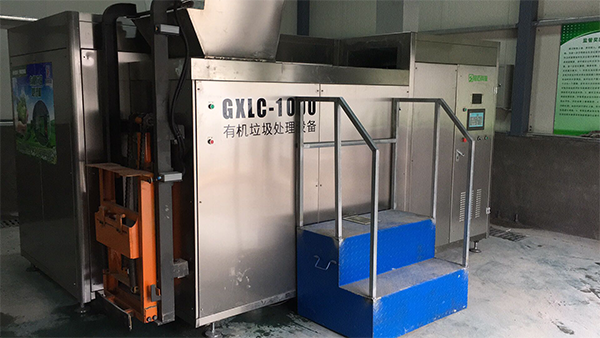Xi'an Food Waste Treatment Equipment Specification
The food waste treatment equipment can automatically complete the three tasks of food waste crushing+dehydration+oil-water separation at the same time. It is a professional equipment that can collect a large amount of grease from kitchen waste (oil collection rate is 5% - 10%, and the water content of waste oil is not more than 5%), so that the waste water can meet the Class III sewage discharge standard. Small size, easy operation, widely used in communities, companies, enterprises, units, canteens, restaurants, hotels, school canteens, hospitals, large restaurants, clubs, business places and other places. Advantages of kitchen waste treatment equipment: for residents: ① reduce the smell of the kitchen, especially the cabinet for storing garbage cans; ② Reduce the possibility of cockroaches and bacteria reproduction; ③ Make the cleaning and discharge of household garbage an easy and clean job; ④ It is conducive to maintaining the sanitary environment of stairwells and residential areas. Environmental sanitation department and property management: ① improve the environmental sanitation operating environment; ② Effectively reduce waste output; ③ Reduce secondary pollution during garbage collection and transportation; ④ Reduce the difficulty and cost of garbage collection and transportation. For municipal and traffic management departments: increase the content of perishable organics in sewage, which is conducive to the biochemical process of sewage treatment plant; Reduce the number of garbage trucks and the pollution of garbage and sewage leakage on roads. For environment and resource recovery: ① reduce the pollution of kitchen waste on recyclables and improve the resource recovery rate; ② Improve the treatment conditions of landfills and incineration plants, and reduce the discharge of leachate, biogas, flue gas and other pollutants.

Xi'an Food Waste Treatment Equipment Specification
Types and characteristics of food waste treatment equipment: centrifugal fan: all three kinds of sludge can be integrated, but it consumes high energy and causes loud noise quickly. Continuous filtration: the sludge is mixed with organic chemical sludge, with low water content, poor adaptability to mixed sludge and biochemical sludge, more sludge flowing back, large water demand for backwashing, and high energy consumption. Several characteristics of food waste treatment equipment: automation technology. Compared with the traditional kitchen waste treatment equipment, the actual operation of modern machinery and equipment has a higher level of automation technology, without too much manual operation. Full automatic feeding, full automatic express sorting, full automatic temperature control, full automatic feeding, completely achieve automation technology. Low cost. Compared with preparatory treatment, the cost of preparatory treatment is higher. At present, the cost of machinery and equipment can be low. At the same time, recycling food waste and producing fertilizer can offset part of the cost. The total area is small. It is applied together with the usual crushing, oil-water separator, treatment equipment and other equipment, and now it is solved in an integrated way. It does not occupy so many areas, but also quickly. Intelligent data information. The integrated machine equipment is equipped with a monitoring system, which can monitor the disposal status of the system machine equipment in real time, connect the network with the environmental protection bureau, and transmit data to the units that must be supervised.

Xi'an Food Waste Treatment Equipment Specification
What equipment does the food waste pretreatment equipment mainly include? The food waste pretreatment equipment mainly includes: the silo collection system: the main function of the silo is to store the materials in a centralized temporary manner, which can effectively collect materials, provide continuous materials for subsequent equipment, and at the same time, the silo can preliminarily dewater the materials. Automatic sorting machine: mainly used to break bags, disperse, screen sediment or swill, and wind select plastic bags and other light substances. Squeeze dehydrator: Squeeze and dehydrate food waste. Combined with the whole set of food waste treatment equipment, the reduction rate of food waste after dehydration can reach about 60% - 70%. Jiangsu Light Stone Technology Co., Ltd. mainly produces food waste reduction machines, food waste treatment equipment, kitchen waste treatment equipment, organic waste treatment equipment, kitchen waste treatment equipment, perishable waste treatment equipment, wet waste treatment equipment, biochemical treatment equipment for kitchen waste, waste treatment equipment for farmers' markets, fruit and vegetable waste treatment equipment. Welcome to consult!

Xi'an Food Waste Treatment Equipment Specification
In our daily life, a large amount of food waste will be generated. These food waste accounts for a relatively high proportion of the total domestic waste, which is one of the difficult problems in waste classification and treatment. Whether it is collection, storage and transportation, or terminal treatment, a lot of manpower and material resources need to be invested. In fact, with the continuous development of the times, we can easily overcome the problem of food waste treatment by using food waste treatment equipment. The food waste treatment equipment can realize the "local collection - local treatment - local transformation - resource recovery" mode of food waste, so that food waste can be effectively collected, transported and disposed in a unified manner, and it is also convenient to effectively solve food safety problems such as "gutter oil" and "swill pig". The food waste treatment equipment based on multi bacteria integrates multidisciplinary technology, and through the cooperation of mechanical structure, intelligent control and multi bacteria, constructs a microbial (bacteria) fermentation environment, realizes intelligent treatment of food waste, and improves the degradation rate of food waste.







